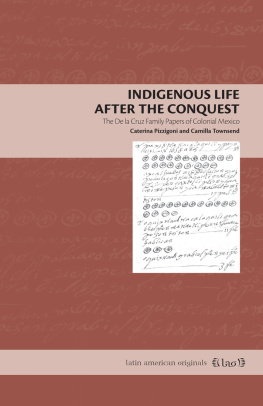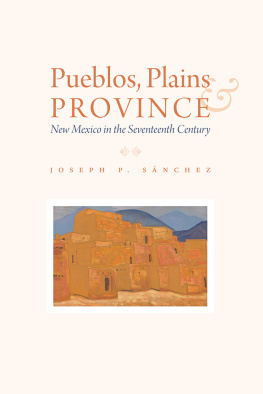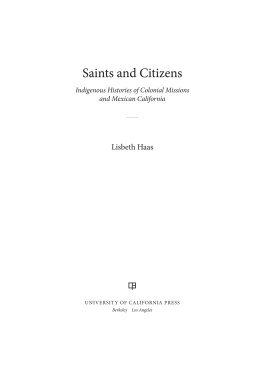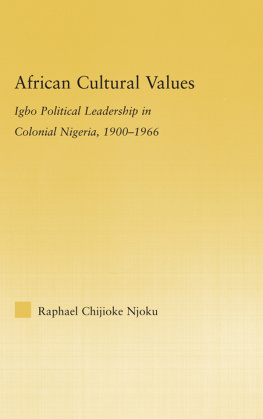INDIGENOUS LIFE AFTER THE CONQUEST

INDIGENOUS LIFE AFTER THE CONQUEST
The De la Cruz Family Papers of Colonial Mexico
Caterina Pizzigoni and Camilla Townsend
The Pennsylvania State University Press
University Park, Pennsylvania
Library of Congress Cataloging-in-Publication Data
Names: Pizzigoni, Caterina, compiler. | Townsend, Camilla, 1965 compiler. | Cruz (Family : approximately 1620 Cruz, Pedro de la, approximately 16201675), creator. | Cruz, Pedro de la, approximately 16201675, author. | Cruz, Juan de la, approximately 16401691, author.
Title: Indigenous life after the conquest : the De la Cruz family papers of colonial Mexico / Caterina Pizzigoni and Camilla Townsend [compilers].
Other titles: Latin American originals ; 16.
Description: University Park, Pennsylvania : The Pennsylvania State University Press, [2021] | Series: Latin american originals ; 16 | Includes bibliographical references and index. | English translations of originals in Nahuatl and Spanish; one document includes the original Nahuatl.
Summary: Examines a rare set of family documents from central Mexico, originally written in Nahuatl, from the seventeenth to the early nineteenth century. Illustrates a complex indigenous world, with the challenges and opportunities of life within the Spanish colonial systemProvided by publisher.
Identifiers: LCCN 2021000212 | ISBN 9780271088136 (paperback)
Subjects: LCSH: Cruz familyArchives. | Cruz, Pedro de la, approximately 16201675Archives. | Cruz, Juan de la, approximately 16401691Archives. | NahuasMexicoTepemaxalcoHistory17th centurySources. | NahuasMexicoTepemaxalcoSocial life and customs17th centurySources. | Tepemaxalco (Mexico)History17th centurySources. | Tepemaxalco (Mexico)Social life and customs17th centurySources. | Tepemaxalco (Mexico)Church history17th centurySources.
Classification: LCC F1221.N3 P59 2021 | DDC 972/.4802dc23
LC record available at https://lccn.loc.gov/2021000212
Copyright 2021 Caterina Pizzigoni and Camilla Townsend
All rights reserved
Printed in the United States of America
Published by The Pennsylvania State University Press,
University Park, PA 16802-1003
The Pennsylvania State University Press is a member of the Association of University Presses.
It is the policy of The Pennsylvania State University Press to use acid-free paper. Publications on uncoated stock satisfy the minimum requirements of American National Standard for Information SciencesPermanence of Paper for Printed Library Material, ANSI Z 39.48-1992.
This book is dedicated to the memory of Jim Lockhart, without whom it would never have been written.CONTENTS
Nahuatl text
English text
Latin American Originals (LAO) is a series of primary-source texts on colonial Latin America. LAO volumes are accessible editions of texts translated into Englishmost of them for the very first time. Of the sixteen volumes now in print, nine illuminate aspects of the Spanish invasions in the Americas during the long century of 14941614. The other seven take the series in varied and exciting directions, from the spiritual conquest to medical science; the present volume acts as a bridge between the invasion-era volumes and those exploring the mid- and late colonial periods.
Taken in the chronological order of their primary texts, Of Cannibals and Kings (LAO 7) comes first. It presents the earliest written attempts to describe Native American cultures, offering striking insight into how the first Europeans in the Americas struggled from the very start to conceive a New World. The Native Conquistador (LAO 10) tells the story of the (in)famous Spanish Conquest expeditions into Mexico and Central America from 1519 to 1524but from the startlingly different perspective of an indigenous dynasty, with Ixtlilxochitl, ruler of Tetzcoco, the alternative leading protagonist, as recounted by his great-great-grandson.
Next, chronologically, are LAOs 2, 1, and 9. Invading Guatemala shows how reading multiple accounts of conquest wars (in this case, Spanish, Nahua, and Maya versions of the Guatemalan conflict of the 1520s) can explode established narratives and suggest a more complex and revealing conquest story. Invading Colombia challenges us to view the difficult Spanish invasion of Colombia in the 1530s as more representative of conquest campaigns than the better-known assaults on the Aztec and Inca Empires. It complements The Improbable Conquest, which presents letters written between 1537 and 1556 by Spaniards strugglingwith a persistence that is improbable indeedto found a colony along the hopefully named Ro de la Plata.
Contesting Conquest (LAO 12) adds intriguingly to that trio, offering new perspectives on Nueva Galicias understudied early history. Indigenous witnesses and informants, their voices deftly identified, selected, and presented, guide us through the grim, messy tale of repeated efforts at conquest and colonization from the late 1520s through 1545.
LAOs 11, 3, 4, and 16 (this volume) all explore aspects of the aftermath and legacy of the invasion era. The History of the New World offers the first English translation since 1847 of part of a 1565 Italian book that, in its day, was a best seller in five languages. The merchant-adventurer Girolamo Benzoni mixes sharp observations and sympathy for indigenous peoples with imaginary tales and wild history, influencing generations of early modern readers and challenging modern readers to sort out fact from fable. The Conquest on Trial features a fictional indigenous embassy filing a complaint in a court in Spainthe Court of Death. The first theatrical examination of the conquest published in Spain, it effectively condenses contemporary debates on colonization into one dramatic package. It contrasts well with Defending the Conquest, which presents a spirited, ill-humored, and polemic apologia for the Spanish Conquest, written in 1613 by a veteran conquistador.
The present volume chronologically follows those three. In Indigenous Life After the Conquest, Caterina Pizzigoni and Camilla Townsend, two master scholars of Nahua history and culture, present the papers of a Nahua family, showing how family members navigated the gradual changes and challenges that swept central Mexico in the century after the dramatic upheaval of invasion and conquest. Through indigenous eyes we see how a new order was built, contested, shaped, and reconfigured by Nahuas themselves.
LAO 16 dovetails in many ways with volumes 13, 6, 5, and 8which explore aspects of Spanish efforts to implant Christianity in the Americas. Chronologically, To Heaven or to Hell leads the pack, presenting the first complete English translation of a book by Bartolom de Las Casas. Originally published in 1552, his Confessionary for Confessorssoon overshadowed by his famous Very Brief Account of the Destruction of the Indieswas initially just as controversial; conquistadors and other Spaniards were outraged by its demand that they themselves be effectively made subject to the spiritual conquest in the Americas.
Gods of the Andes presents the first English edition of a 1594 manuscript describing Inca religion and the campaign to convert native Andeans. Its Jesuit author is surprisingly sympathetic to preconquest beliefs and practices, viewing them as preparing Andeans for the arrival of the new faith. Forgotten Franciscans casts new light on the spiritual conquest and the conflictive cultural world of the Inquisition in sixteenth-century Mexico. Both LAO 6 and 5 expose wildly divergent views within the Spanish American church on native religions and how to replace them with Christianity. Complementing those two volumes by revealing the indigenous side to the same process,










